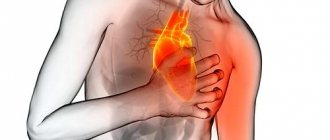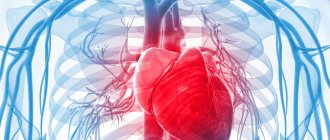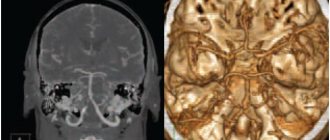Cerebrovascular insufficiency is one of the most common clinical syndromes in neurology, which, according to preventive examinations of the population, is detected in 20-30% of patients of working age and amounts to at least 700 cases per 100,000 population. With the progressive course of the vascular process, insufficiency of cerebral hemodynamics leads to extremely severe outcomes - stroke and vascular dementia, and therefore its timely diagnosis and adequate therapy are extremely relevant [1-3]. Chronic cerebral ischemia develops gradually, treatment is carried out when clinical manifestations already exist. At the same time, it is advisable to begin providing assistance with preventive measures that prevent the development of severe organic changes in the brain.
The etiology of cerebrovascular diseases in young patients differs from that in middle and old age, where chronic diseases (diabetes mellitus, arterial hypertension, cerebral atherosclerosis) prevail. In young people, hemodynamic disorders are often not associated with vasostructural changes; autonomic dysregulation, leading to vasospasm, plays a significant role in their genesis. A significant contribution to hemodynamic disorders is made by disturbances of venous outflow [3-6].
It has been shown [7–9] that changes in the microcirculatory system often occur long before the development of severe vascular disorders, therefore, in the treatment of patients with mild cerebrovascular disorders, especially in combination with existing autonomic dysfunction, it is necessary to include drugs that affect the microcirculatory hemodynamics.
Due to the lack of adequate early drug and non-drug correction at the initial stage of vascular disorders in young patients, manifested by spasm of cerebral vessels and difficulty in intracranial venous outflow, the condition worsens, leading to the gradual development of chronic cerebral ischemia.
Traditional therapy used in the correction of cerebrovascular diseases does not always take into account the peculiarities of the pathogenesis of disorders in young patients and therefore it is not always effective. A differentiated approach in the treatment of young patients is relevant, since inappropriate combinations of drugs lead to polypharmacy. In this regard, a more detailed study of the effect of the most commonly used drugs on both cerebral blood flow and the microcirculation system is necessary.
Mexidol is a domestic original drug, the anti-ischemic effect of which is realized due to the pronounced antioxidant and antihypoxic, vegetative-corrective effect. It occupies a special position because it affects various parts of free radical processes in biomembranes and inside the cell and does not have a pro-oxidant effect. Mexidol consists of two related and functionally significant compounds: 2-ethyl-6-methyl-3-hydroxypyridine and succinic acid. The presence of 3-hydroxypyridine in the structure of Mexidol provides a complex of its antioxidant and membranotropic effects, the ability to reduce glutamate excitotoxicity, and modulate the functioning of receptors. The antihypoxic effect of Mexidol is mainly associated with the presence of succinate in its structure, which is an antihypoxant with a direct energizing effect, affecting the endogenous respiration of mitochondria with the activation of their energy-synthesizing function. In addition, succinate stimulates the diffusion of oxygen into various organs and tissues, while improving cellular respiration and oxygen utilization by tissues, restoring NAD-dependent respiration. The role of oxypyridine in the implementation of the anti-ischemic effect of Mexidol is expressed in improving microcirculation by eliminating vascular endothelial dysfunction through reducing the level of free radical oxidation of lipids; improving the rheological properties of blood by reducing platelet aggregation; reducing vasospastic activity by reducing the activity of free radical oxidation of lipids and improving the functional state of platelet and erythrocyte membranes. Oxypyridine is also “responsible” for stimulating the synthesis of nitric oxide, a powerful vasodilation factor. Succinate improves microcirculation and normalization of vascular tone by regulating vascular tone against the background of normalizing the ratio of histamine and serotonin in the blood, activates the reserve succinate dehydrogenase oxidation pathway and restores the activity of the key redox enzyme of the respiratory chain of cell mitochondria - cytochrome oxidase [10, 11].
Vinpocetine is a drug that improves cerebral circulation. It has a positive effect on brain metabolism by increasing the consumption and utilization of glucose and oxygen by brain tissue and, therefore, improving the tolerance of hypoxia by brain cells. The drug activates adenylate cyclase and inhibits phosphodiesterase type 1, which is involved in the regulation of cerebral vascular tone. As a result, cerebral blood flow improves and the delivery of glucose to brain tissue is enhanced. Vinpocetine inhibits platelet aggregation, reduces pathologically increased blood viscosity, especially at low shear rates, normalizes the deformability of erythrocytes, and promotes interstitial oxygen transport. The drug selectively increases cerebral blood flow and reduces cerebral vascular resistance without affecting systemic circulation [12].
The purpose of the study was to evaluate the effect of mono- and combination therapy with the drug Mexidol in young patients with cerebral angiodystonia.
General information
Cerebral angiodystonia is a functional pathology, which is characterized by changes in the venous and arterial tone of cerebral vessels, as well as a decrease in their adaptive abilities. Cerebral angiodystonia is formed as a result of a violation of nervous vascular regulation, which leads to:
- venous congestion in the brain;
- insufficient blood supply to the brain.
Cerebral angiodystonia of cerebral vessels is a functional disorder in which the arteries and veins remain morphologically intact - there are no signs of thrombosis or atherosclerosis .
Angiodystonia of cerebral vessels occurs in 1.7% of the population. Every third patient suffering from pathology is of working age. The main danger lies in the fact that the disease can complicate diagnosis and mask the clinical picture of serious diseases of the cardiovascular and central nervous systems.
Retinal angiodystonia is a disease that affects the vessels supplying the bottom of the eyeball.
Pathology can develop at any age. One option is spastic angiodystonia of the retina, which develops as a result of prolonged spasm of the venous and arterial network of the fundus.
Laser coagulation of the retina
| Name of procedure | Price |
| Laser coagulation for peripheral retinal degeneration (RPD) | 3,500 UAH. |
| Laser coagulation for peripheral retinal degeneration (complicated option, indications are determined by a retinologist) | 3,800 UAH. |
| Laser coagulation for diabetic retinopathy (DRP), thrombosis, central serous retinopathy and other vascular abnormalities, first session | 3,200 UAH. |
| Laser coagulation for diabetic retinopathy (DRP), thrombosis, central serous retinopathy and other vascular abnormalities, subsequent sessions | 2,000 UAH. |
| Laser coagulation of the “Grid” type, for macular pathology (lacerations, cystoid macular edema, etc.) | 3,000 UAH. |
| YAG laser dissection of secondary membranous cataracts, pupillary films, iridotomy, schwartotomy in the anterior and middle third of the vitreous body using the Ellex SuperQ YAG laser | 3,800 UAH. |
| Selective laser tubeculoplasty (SLT) for open-angle glaucoma | 3,500 UAH. |
| Additional peripheral laser coagulation procedure (small volume up to 200 pulses) | 1,800 UAH |
| Panretinal laser coagulation | 4000 UAH |
The price is for treatment of one eye.
SIGN UP FOR VISION DIAGNOSTICS
Classification
Based on its origin, cerebral angiodystonia is divided into:
- Primary form. It is an independent disease, also known as neurogenic angiodystonia.
- Symptomatic form. Changes in vascular tone are the result or complication of an underlying pathology, for example, arterial hypertension .
By localization they distinguish:
- Local form. The affected area has a clear localization and is limited.
- Diffuse or systemic form. Changes are observed in all areas of the brain.
With the flow:
- Crisis angiodystonia. The paroxysmal form is characterized by a periodically occurring sharp deterioration in well-being against the background of complete well-being.
- Constant angiodystonia. Cerebral circulatory disorders are persistent and persistent.
Type:
- Hypertensive type. Develops against a background of constantly elevated blood pressure. The development mechanism is associated with vasospasm, which develops against the background of contraction of smooth muscle tissue in the vascular wall, and leads to a narrowing of the lumen of the vessel, which negatively affects blood circulation.
- Mixed type. It is formed as a result of instability of the condition of the walls of blood vessels, which alternately contract and relax. Pathology is directly related to the psychophysiological state of the patient.
- Hypotonic type. Develops in people with low blood pressure - hypotension.
It is characterized by a relaxed state of the vascular wall and an increase in the lumen of arteries and veins.
According to the degree of severity, which is determined by the clinical picture of vascular pathology:
- mild form of dystonia;
- moderate angiodystonia;
- a pronounced form of cerebral anhidystonia.
Treatment methods
Retinal angiodystonia is always treated comprehensively. The main direction of therapy is to eliminate the cause of vascular insufficiency. Treatment also includes correction of some habits:
- quitting smoking and alcohol or minimizing them;
- stabilization of physical activity - increasing activity with obvious physical inactivity and restrictions with increased loads;
- changing the daily routine, alternating activity and rest;
- following a diet appropriate to the underlying disease.
Treatment also includes taking medications that help restore blood supply to the retina. Local remedies in the form of drops that improve eye nutrition are often used - Mildronate, Trental and their analogues. More focused therapy is prescribed depending on the type of disease.
Treatment of hypertensive angiodystonia
Since hypertensive angiodystonia of the retina can result in a catastrophe for vision with a sharp increase in blood pressure, patients are recommended to take medications on an ongoing basis that regulate this indicator - Captopril, Tenoric and their analogues. Additionally, a complex of drugs is prescribed to help stabilize vascular tone and eliminate factors contributing to their spasm:
- sedatives - motherwort and valerian, Corvalol;
- antiarrhythmic drugs - "Verapamil";
- diuretics (if necessary, quickly reduce blood pressure) - Enalapril or Hypothiazide.
To reduce current symptoms, analgesics and antispasmodics can be prescribed.
Treatment of hypotonic angiodystonia
In the hypotonic form of the disease, drugs are used to increase and stabilize blood pressure. The drugs chosen are predominantly of natural origin containing extracts of lemongrass, ginseng and echinacea. These plants are powerful adaptogens, strengthen the immune system and help improve vascular tone.
Additionally, the following may be prescribed:
- means for improving cerebral blood circulation - “Piracetam”, “Pantocalcin”;
- local drugs to enhance microcirculation - “Taufon” and “Emoxipin”;
- vitamins with components beneficial for vision - “Lutein Complex” and “Aevit”.
For any type of disease, the effectiveness of conservative therapy increases with the use of physiotherapeutic methods: magnetic therapy, acupuncture, electrophoresis. Any medications and procedures can only be used after consulting a doctor!
Causes
The main factors and pathologies that lead to the development of cerebral vascular anhidystonia:
- impaired regulation of the autonomic nervous system;
- endocrinological diseases: hypothyroidism ; pheochromocytoma ; diabetes ; hyperthyroidism ;
- neuroinfections: encephalitis , meningoencephalitis , meningitis ;
- acute or chronic form of intoxication: hangover syndrome; food poisoning ; poisonous gas intoxication; consumption of alcohol, drugs, nicotine;
- long-term consequences of traumatic brain injury;
- pathology of internal organs;
- psycho-emotional disorders associated with neuropsychic overstrain, prolonged stress, lack of sleep;
- occupational pathology (exposure to loud noise, vibration disease);
- hypertonic disease.
In children, the disease develops against the background of a congenital pathology of the central nervous system. Quite often, the pathology of vascular tone is associated with psychosomatics. The lack of skills to get rid of neuropsychic stress, an unconstructive approach to solving the problem (addictive behavior or abuse of alcoholic beverages) leads to chronic stress, which negatively affects the functioning of the autonomic nervous system.
Symptoms
The clinical picture of cerebral angiodystonia is nonspecific. Characteristic signs of pathology:
- Mental and emotional disorders that manifest themselves: memory impairment; excessive fatigue; mood lability; superficial sleep; absent-mindedness; decreased interest in events happening around; lack of hobbies and any interest; complete apathy; increasing time to fall asleep.
- Autonomic disorders in the form of: instability of blood pressure ; rhythm disturbances and shortness of breath; feeling of rapid heartbeat .
The clinical picture is formed from several syndromes. The predominance of a particular syndrome depends on the condition of a particular organ or system (congenital or acquired pathology). For example, with congenital heart disease, it is cardiac neurosis .
Syndromes that accompany cerebral angiodystonia:
- Cardialgic syndrome. Patients complain of retrosternal pain in the heart area of a burning, aching, bursting nature. The pain syndrome is more pronounced in the area of the apex of the heart and is short-term in nature (from several minutes to 1 hour). The pain attack stops on its own when the patient is distracted. The syndrome is accompanied by feelings of anxiety, fear, agitation and shortness of breath.
- Breathing syndrome. Occurs in 85% of patients suffering from angiodystonia. Characteristic symptoms: feeling of lack of air; discomfort along the upper respiratory tract and discomfort in the lungs.
The paroxysmal (crisis) form of angiodystonia includes 3 types of crisis:
- Sympathoadrenal crisis. Characterized by the following symptoms: instability of blood pressure; sudden feeling of fear or anxiety; increased body temperature; dryness and pallor of the skin; sudden headache of aching nature with a feeling of pulsation; feeling of rapid heartbeat; tremor, trembling in the limbs. The crisis ends with general weakness, and in some cases, excessive urination.
- Parasympathetic crisis . Characteristic symptoms: dizziness; decreased blood pressure; bursting headache; excessive moisture of the skin; dyspnea; decreased heart rate.
- Mixed crisis. Symptoms of sympathoadrenal and parasympathetic crises are characteristic.
According to severity they are distinguished:
- Easy. The duration of the attack is no more than 20 minutes and is manifested by one separate syndrome.
- Average. The duration of the attack is 20-60 minutes, manifested by two syndromes. After the crisis, exhaustion is noted, which can last 1-2 days.
- Heavy. The attack lasts more than 1 hour and is manifested by 2 or more syndromes. Convulsive seizures and severe autonomic dysfunction are characteristic. After an attack, exhaustion can last 2-3 days, and the ability to work is significantly reduced.
The clinical picture of angiodystonia depends on the form of pathology:
- Hypertensive type. The disease occurs as a dyscirculatory encephalopathy and is characterized by a pronounced decrease in some psychophysiological indicators (pace of thinking, memory, attention, speed of reactions). The clinical picture is manifested by specific autonomic disorders: noticeable pulsation of the vessels of the head and neck; extrasystolic arrhythmia ; increase in heart rate at rest and during excitement.
- Hypotensive type. Registered when systolic blood pressure decreases below 100 mm Hg. Art. Characteristic autonomic disorders: tendency to faint (loss of consciousness is associated with insufficient blood supply to the brain); chilliness of the limbs. Patients have pale skin, the skin feels moist and cold to the touch. Blood pressure levels normalize with physical activity and decrease at rest. There is a decrease in peripheral vascular tone.
- Angiodystonia with venous dysfunction. The pathology is formed against the background of changes in the tone of the venous vessels of the brain, which leads to venous stagnation. The symptoms of hypertensive-hydrocephalic syndrome are characteristic: increased sensitivity to loud sounds and bright light; irritability ; apathy; aching headache; vomit; nausea.
How to recognize
We have collected all the signs of angiodystonia that can be used to determine its presence. The situation is complicated by the presence of underlying diseases, against which the problem of interest to us arises. And yet, the presence of angiodystonia can be detected by the following symptoms:
- pain in different areas of the body, it can be the cervical spine, back, limbs;
- allergic manifestations that have not previously bothered or appeared;
- frequent occurrence of loose stools.
One of the types of the problem is cerebral angiodystonia, which is characterized by disruption of the blood vessels of the brain. In this case, the symptoms of angiodystonia will look like this:
- pain in the temples and back of the head, which can be aching, throbbing or dull;
- numbness in the arms and legs;
- manifestation of swelling;
- increased changes in blood pressure;
- pain in the area of the heart muscle;
- arrhythmia, dizziness, lightheadedness, darkening of the eyes;
- impaired memory, vision, sleep deterioration;
- general weakness in the body, drowsiness and increased fatigue;
- dysfunction of the endocrine system;
- uncontrollable emotions and prolonged depression.
If most of these symptoms do not go away after adjusting your diet, lifestyle and long rest, then you should immediately visit a doctor and undergo the diagnostics prescribed by him. By the way, it is precisely the principle of diagnostics for identifying angiodystonia that we will consider in the next section.
Tests and diagnostics
Cerebral angiodystonia is a diagnosis of exclusion when, as a result of the examination, functional and organic changes in the vessels of the brain are not detected. Due to the diversity and nonspecificity of the clinical picture, the diagnostic search can take months.
Several specialized specialists take part in the differential diagnosis: cardiologist, neurologist, psychiatrist and endocrinologist. At the initial stage, a family history and heredity of autonomic dysfunction are established: the presence of disorders in the blood circulation of the brain in close relatives. Concomitant pathology is revealed. Often such patients are simultaneously diagnosed with:
- allergic reactions;
- ulcerative lesions of the digestive tract;
- skin diseases;
- bronchial asthma;
- endocrinological pathology;
- rhythm disturbances, arrhythmia .
Instrumental diagnostic methods used for cerebral angiodystonia:
- electrocardiography;
- functional tests;
- CT scan;
- electroencephalography.
Prevention and exercises for cerebral angiodystonia
The development and progression of cerebral angiodystonia can be prevented by following simple rules:
- review your diet;
- change your lifestyle;
- to refuse from bad habits;
- do gymnastics and sports.
Exercises for cerebral vessels are aimed at improving venous outflow from the head. Massage of the cervical-collar area and exercises to relieve muscle spasm in the cervical spine are effective. Regular exercises for the blood vessels of the brain have a positive effect on the condition of the vascular wall and overall well-being.







